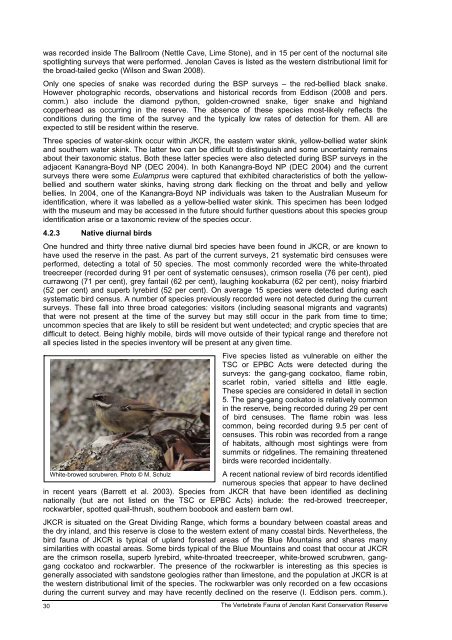The Vertebrate Fauna of Jenolan Karst Conservation Reserve: Final
The Vertebrate Fauna of Jenolan Karst Conservation Reserve: Final
The Vertebrate Fauna of Jenolan Karst Conservation Reserve: Final
You also want an ePaper? Increase the reach of your titles
YUMPU automatically turns print PDFs into web optimized ePapers that Google loves.
was recorded inside <strong>The</strong> Ballroom (Nettle Cave, Lime Stone), and in 15 per cent <strong>of</strong> the nocturnal site<br />
spotlighting surveys that were performed. <strong>Jenolan</strong> Caves is listed as the western distributional limit for<br />
the broad-tailed gecko (Wilson and Swan 2008).<br />
Only one species <strong>of</strong> snake was recorded during the BSP surveys – the red-bellied black snake.<br />
However photographic records, observations and historical records from Eddison (2008 and pers.<br />
comm.) also include the diamond python, golden-crowned snake, tiger snake and highland<br />
copperhead as occurring in the reserve. <strong>The</strong> absence <strong>of</strong> these species most-likely reflects the<br />
conditions during the time <strong>of</strong> the survey and the typically low rates <strong>of</strong> detection for them. All are<br />
expected to still be resident within the reserve.<br />
Three species <strong>of</strong> water-skink occur within JKCR, the eastern water skink, yellow-bellied water skink<br />
and southern water skink. <strong>The</strong> latter two can be difficult to distinguish and some uncertainty remains<br />
about their taxonomic status. Both these latter species were also detected during BSP surveys in the<br />
adjacent Kanangra-Boyd NP (DEC 2004). In both Kanangra-Boyd NP (DEC 2004) and the current<br />
surveys there were some Eulamprus were captured that exhibited characteristics <strong>of</strong> both the yellowbellied<br />
and southern water skinks, having strong dark flecking on the throat and belly and yellow<br />
bellies. In 2004, one <strong>of</strong> the Kanangra-Boyd NP individuals was taken to the Australian Museum for<br />
identification, where it was labelled as a yellow-bellied water skink. This specimen has been lodged<br />
with the museum and may be accessed in the future should further questions about this species group<br />
identification arise or a taxonomic review <strong>of</strong> the species occur.<br />
4.2.3 Native diurnal birds<br />
One hundred and thirty three native diurnal bird species have been found in JKCR, or are known to<br />
have used the reserve in the past. As part <strong>of</strong> the current surveys, 21 systematic bird censuses were<br />
performed, detecting a total <strong>of</strong> 50 species. <strong>The</strong> most commonly recorded were the white-throated<br />
treecreeper (recorded during 91 per cent <strong>of</strong> systematic censuses), crimson rosella (76 per cent), pied<br />
currawong (71 per cent), grey fantail (62 per cent), laughing kookaburra (62 per cent), noisy friarbird<br />
(52 per cent) and superb lyrebird (52 per cent). On average 15 species were detected during each<br />
systematic bird census. A number <strong>of</strong> species previously recorded were not detected during the current<br />
surveys. <strong>The</strong>se fall into three broad categories: visitors (including seasonal migrants and vagrants)<br />
that were not present at the time <strong>of</strong> the survey but may still occur in the park from time to time;<br />
uncommon species that are likely to still be resident but went undetected; and cryptic species that are<br />
difficult to detect. Being highly mobile, birds will move outside <strong>of</strong> their typical range and therefore not<br />
all species listed in the species inventory will be present at any given time.<br />
Five species listed as vulnerable on either the<br />
TSC or EPBC Acts were detected during the<br />
surveys: the gang-gang cockatoo, flame robin,<br />
scarlet robin, varied sittella and little eagle.<br />
<strong>The</strong>se species are considered in detail in section<br />
5. <strong>The</strong> gang-gang cockatoo is relatively common<br />
in the reserve, being recorded during 29 per cent<br />
<strong>of</strong> bird censuses. <strong>The</strong> flame robin was less<br />
common, being recorded during 9.5 per cent <strong>of</strong><br />
censuses. This robin was recorded from a range<br />
<strong>of</strong> habitats, although most sightings were from<br />
summits or ridgelines. <strong>The</strong> remaining threatened<br />
birds were recorded incidentally.<br />
White-browed scrubwren. Photo © M. Schulz<br />
A recent national review <strong>of</strong> bird records identified<br />
numerous species that appear to have declined<br />
in recent years (Barrett et al. 2003). Species from JKCR that have been identified as declining<br />
nationally (but are not listed on the TSC or EPBC Acts) include: the red-browed treecreeper,<br />
rockwarbler, spotted quail-thrush, southern boobook and eastern barn owl.<br />
JKCR is situated on the Great Dividing Range, which forms a boundary between coastal areas and<br />
the dry inland, and this reserve is close to the western extent <strong>of</strong> many coastal birds. Nevertheless, the<br />
bird fauna <strong>of</strong> JKCR is typical <strong>of</strong> upland forested areas <strong>of</strong> the Blue Mountains and shares many<br />
similarities with coastal areas. Some birds typical <strong>of</strong> the Blue Mountains and coast that occur at JKCR<br />
are the crimson rosella, superb lyrebird, white-throated treecreeper, white-browed scrubwren, ganggang<br />
cockatoo and rockwarbler. <strong>The</strong> presence <strong>of</strong> the rockwarbler is interesting as this species is<br />
generally associated with sandstone geologies rather than limestone, and the population at JKCR is at<br />
the western distributional limit <strong>of</strong> the species. <strong>The</strong> rockwarbler was only recorded on a few occasions<br />
during the current survey and may have recently declined on the reserve (I. Eddison pers. comm.).<br />
30<br />
<strong>The</strong> <strong>Vertebrate</strong> <strong>Fauna</strong> <strong>of</strong> <strong>Jenolan</strong> <strong>Karst</strong> <strong>Conservation</strong> <strong>Reserve</strong>

















